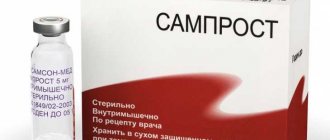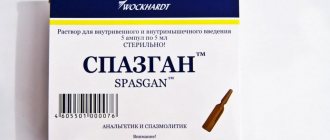Pharmacological action of Ditilin
The instructions for Ditilin say that this drug helps block neuromuscular transmission. As a result of the fact that the drug actively interacts with H-cholinergic receptors, depolarization of the end plate occurs, as well as the membranes adjacent to it. As a result, muscle twitching occurs, which indicates a slight facilitation of neuromuscular transmission. The walls, being in a depolarized state, do not carry out subsequent impulses, thereby provoking spastic paralysis. After intravenous administration of Ditilin, immobilization of the entire body begins with the muscles of the eyelids, muscles of the fingers, eyes, arms and legs, neck, back and abdomen, and ends with the intercostal muscles and diaphragm.
It was also noted that the use of Ditilin is also suitable for general anesthesia, while increasing intracranial pressure and cerebral blood flow.
Side effects
When using Ditilin, the patient may experience the following side effects:
- increase in gastric pressure, usually during pregnancy and in the presence of formations in the abdominal cavity;
- strong secretion of saliva;
- blood pressure surges;
heart rhythm disturbances and tachycardia;- critical decrease in blood pressure in children;
- cardiac arrest and ventricular fibrillation;
- development of cardiogenic shock;
- anaphylactic shock and bronchospasm;
- skin rashes, often urticaria;
- a sharp increase in potassium and calcium in the blood serum;
- redness of the skin;
- strong muscle contractions, which causes the medication to have the opposite effect;
- prolonged muscle paralysis necessarily requires symptomatic treatment;
- laryngospasm and prolonged apnea, more often in people with increased body weight and a deviated nasal septum;
- development of renal failure, usually due to high potassium levels;
- increase in intracranial pressure, especially in patients with head injuries and multiple bruises;
Overdose
Did you know that...
Next fact
In case of overdose, all the side effects described above may occur. More often, respiratory arrest or severe depression occurs. Patients with problems in the functioning of the respiratory system are at particular risk.
Contraindications
It is not recommended to prescribe Ditilin in the presence of the following contraindications::
- hypersensitivity to the active substance or auxiliary components;
- high probability of developing malignant hyperthermia;
- increased amount of potassium in the blood or a high probability of a similar condition;
- severe renal failure, in old age with moderate pathology;
- high degree burns and multiple injuries, especially to the eyes and head;
- severe abdominal infections and the development of sepsis;
- penetrating wounds of the eye with the development of high intraocular pressure;
- high intracranial pressure;
- the presence of myotonia, poliomyelitis and muscle atrophy;
- congenital cholinesterase deficiency.
Use during pregnancy and lactation
The medication is not prohibited from being used during pregnancy if the benefit to the woman outweighs the risk to the child, and there are no problems with cholinesterase levels. There is no data on the penetration of the active substance through the placenta, as well as information on problems encountered for the fetus after administration of the active substance. During lactation, it is necessary to clearly assess the need to use Ditilin, since there is no accurate data on the possible penetration of the drug into breast milk.
Attention! During pregnancy, the drug must be prescribed carefully calculating the dosage. Patients in this group are at increased risk of developing high stomach pressure and other side effects.
Contraindications for use
Ditilin is strictly prohibited for use by patients who suffer from myasthenia gravis, Duchenne muscular dystrophy, and malignant hyperthermia. In addition, if the presence of glaucoma, pulmonary edema, renal failure, or bronchial asthma is detected, the drug cannot be prescribed.
Ditilin should not be prescribed to children under one year of age, as well as to pregnant women.
Additional consultation is required by patients who have prolonged fasting, liver and kidney failure, chronic infections, large areas of burned skin, malignant tumors, tuberculosis, tetanus, collagen diseases, artificial circulation. In addition, special attention should be paid to patients suffering from chronic or acute intoxication with anticholinesterase medications (phospholine, physostigmine, neostigmine) or insecticides. Also, the simultaneous administration of procaine and Ditilin to a patient requires increased attention from medical professionals.
Ditilin is prescribed with caution during the period after childbirth and plasma transfusion.
special instructions
When using Ditilin, several mandatory factors must be taken into account:
- administer the medication only if artificial ventilation equipment is available;
the presence of a resuscitator is mandatory during the procedure;- under the age of one year, it is advisable to stop using the drug due to the high risk of side effects and overdose;
- to reduce the likelihood of bradycardia, a small amount of Atropine can be administered;
- in some patients, the medication causes problems in the form of attention disorders, headaches and dizziness, therefore, if you have such symptoms, you should not use a car or operate complex technical mechanisms;
- during pregnancy and lactation, if later treatment can be carried out, it is recommended to postpone it;
- Patients with abdominal tumors and hernias should be prepared to develop problems in the form of high gastric pressure.
Directions for use and dosage of Ditilin
The drug can be administered intramuscularly and intravenously. In the first case, the effect of the drug is revealed after 2-4 minutes. After IV administration, relaxation occurs within 1 minute, reaching its maximum after 2-3 minutes. (maintaining its state for 3 minutes). The total duration of action of the drug is 5-10 minutes, which depends on the dose of the drug.
0.1 mg/kg – relaxation of the skeletal muscles, 0.2-1 mg/kg – complete relaxation of the respiratory muscles. As a result, conditions arise to control muscle relaxation.
The instructions for Ditilin say that the drug is administered intravenously to adults slowly, in a stream or drip. If necessary, you can change the single dose from 0.1 to 1.5-2 mg/kg.
IM is administered at a rate of 3-4 mg/kg (with the maximum allowable dose being 150 mg). For children, the drug is administered intramuscularly in doses of up to 2.5 mg/kg (not exceeding 150 mg), intravenously – 1-2 mg/kg.
In some cases, it is possible to use Ditilin:
- for tracheal intubation (in these cases, a single dose is 0.2-0.8 mg/kg);
- to stop spontaneous breathing and muscle relaxation (0.2-1 mg/kg);
- for the reduction of dislocations and bones, during endoscopy (0.1-0.2 mg/kg);
- in the treatment of cramps, muscle avulsions (0.1-2.5 mg/kg).
It should be remembered that a single dose should not exceed 150 mg. During the operation, it is allowed to administer the drug at a dose of 0.5-1 mg/kg at certain intervals (every 7 minutes).
Indications
The use of Ditilin is indicated in the following cases:
- Medical procedures when it is necessary to disable the patient’s spontaneous breathing (bronchoscopy, intracheal intubation)
- When complete muscle relaxation is necessary (gynecological, abdominal, thoracic surgical interventions, as well as repositioning of fractures, reduction of dislocations, endoscopy)
- For the symptomatic treatment of tetanus
- In case of strychnine poisoning
- For the prevention of seizures during electropulse therapy
Interaction of Ditilin with other drugs
The use of Ditilin with cardiac glycosides significantly increases the effectiveness of their action.
Slows down the action of drugs that improve memory.
Cannot be used with donor blood, serum preservatives, or alkaline solutions. Interacts positively with sodium chloride solution, fructose solution, dextran solution and Ringer's solution.
The muscle relaxant effect of Ditilin is prolonged and enhanced by such drugs as: procaine, lidocaine, oral contraceptives, beta-blockers, oxytocin, promethazine, aminoglycoside antibiotics, cyclopropane, propanidide, magnesium and lithium salts, quinine, pancuronium, narcotic analgesics, etc.
To reduce the negative effect on the cardiovascular system, atropine is additionally used. Ditilin together with halogen-containing agents has a bad effect on the cardiovascular system.
Ditilin's analogs
Ditilin has no analogues in its effects.
Taking into account different manufacturing countries and manufacturing plants, the drug can be found under several names:
- Ditilin Darnitsa;
- Suxamethonium Biolek;
- Suxamethonium Iodide.
All medications are available in the form of a solution for intramuscular or intravenous administration. They have the same indications and contraindications as Ditilin.
Despite the complete coincidence, if Ditilin is not available in the pharmacy, you should not replace it with an analogue without the knowledge of the doctor. Sometimes various excipients are used to make drugs, which can provoke unwanted reactions from the body.
Registration numbers
solution for intravenous and intramuscular administration of 100 mg/5 ml: amp. 10 pieces. 75/1032/8 (0000-00-00 – 0000-00-00) solution for intravenous and intramuscular administration 100 mg/5 ml: amp. 5 or 10 pcs. LSR-002685/07 (2014-09-07 – 0000-00-00) solution for intravenous administration 2% (100 mg/5 ml): amp. 10 pieces. R No. 003046/01 (2024-11-03 – 2024-11-08) solution for intravenous and intramuscular administration 100 mg/5 ml: amp. 10 pieces. 75/1032/8 (0000-00-00 – 0000-00-00) solution for intravenous and intramuscular administration 100 mg/5 ml: amp. 10 pieces. 75/1032/8 (0000-00-00 – 0000-00-00) solution for intravenous and intramuscular administration 100 mg/5 ml: amp. 5, 10 or 25 pcs. P N010637 (2017-05-10 – 0000-00-00)
Analogues of the drug according to ATC codes:
DITILIN DITILIN-DARNITSA SUXAMETHONIUM IODIDE SUXAMETHONIUM CHLORIDE
Before using the drug DITILIN you should consult your doctor. These instructions for use are for informational purposes only. For more complete information, please refer to the manufacturer's instructions.
Pharmacological properties
Pharmacodynamics
Suxamethonium iodide is a short-acting depolarizing muscle relaxant. Interacts with H-cholinergic receptors and causes depolarization of the end plate (blockade of neuromuscular transmission). The process spreads to nearby membranes, and a generalized, disorganized contraction of myofibrils occurs (i.e., muscle twitching precedes the development of blockade, which results from a short-term facilitation of neuromuscular transmission).
The membranes remain depolarized and do not respond to additional impulses, since repeated impulses associated with repolarization of the end plate are necessary to maintain muscle tone. The result is spastic paralysis.
Myorelaxation after intravenous administration of suxamethonium iodide occurs in a certain sequence. First, the muscles of the eyelids, then the chewing muscles, after which other organs and parts of the body are involved in the process - fingers, eyes, limbs, neck, back and abdomen, vocal cords. The intercostal muscles and diaphragm complete the sequence.
Suxamethonium iodide increases cerebral blood flow and increases intracranial pressure. The onset of action of the drug is observed 54–60 seconds after administration, maximum muscle relaxation develops after 2–3 minutes and persists for 3 minutes in full. Duration of action is from 5 to 10 minutes.
The severity of the drug’s effect is determined by the size of the administered dose:
- 0.1 mg/ml: relaxation of skeletal muscles is noted, while suxamethonium iodide does not have a significant effect on the respiratory system;
- 0.2–1 mg/kg: complete relaxation of the respiratory muscles and abdominal wall occurs; a significant restriction/complete cessation of spontaneous breathing is recorded.
For prolonged muscle relaxation, repeated administration of the solution is required. Controlled and controlled muscle relaxation is achieved due to the rapid onset of the effect and the subsequent rapid restoration of muscle tone.
Pharmacokinetics
After intravenous administration, suxamethonium iodide is distributed in the extracellular fluid and plasma. More than 90% of the substance is hydrolyzed by blood cholinesterase to choline and succinic acid.
The half-life at normal levels of pseudocholinesterase is 90 seconds.
Excretion is carried out by the kidneys. Does not penetrate the intact blood-brain barrier. Does not accumulate.
Contraindications
- Duchenne muscular dystrophy;
- Hyperkalemia;
- Malignant hyperthermia (including history);
- Bronchial asthma;
- Myotonia (congenital and dystrophic);
- Myasthenia;
- Acute liver failure;
- Angle-closure glaucoma;
- Penetrating eye injuries;
- Pulmonary edema;
- Age up to 1 year;
- Pregnancy and lactation (breastfeeding);
- Hypersensitivity to the components of the drug.
Ditilin should be used with caution in the following diseases/conditions:
- Decreased activity of serum pseudocholinesterase (anemia, end-stage liver failure, widespread burns, cachexia, chronic infections, prolonged fasting, trauma);
- Chronic renal failure;
- Condition after plasma transfusion;
- Postpartum period;
- Plasmapheresis;
- Tuberculosis;
- Tetanus;
- Artificial blood circulation;
- Malignant neoplasms;
- Systemic connective tissue diseases;
- Myxedema;
- Emergency surgical interventions in patients with a “full stomach”;
- Chronic and acute intoxication with insecticides - cholinesterase inhibitors (if ingested) or anticholinesterase agents (physostigmine, neostigmine, distigmine bromide);
- Concomitant use with drugs that compete with succinylcholine for cholinesterase (intravenous procaine).
Instructions:
Clinical and pharmacological group
21.013 (Muscle relaxant of peripheral action of depolarizing type)
pharmachologic effect
Short-acting depolarizing muscle relaxant. Causes a blockade of neuromuscular transmission. Interacting with n-cholinergic receptors, it causes depolarization of the end plate. The process spreads to the adjacent membranes, and a generalized disorganized contraction of myofibrils occurs (i.e., the development of blockade is preceded by muscle twitching - the result of short-term facilitation of neuromuscular transmission). The membranes, remaining depolarized, do not respond to additional impulses, since maintaining muscle tone requires the receipt of repeated impulses associated with repolarization of the end plate, spastic paralysis occurs. After IV administration, muscle relaxation occurs in the following sequence: muscles of the eyelids, chewing muscles, muscles of the fingers, eyes, limbs, neck, back and abdomen, vocal cords; then the intercostal muscles and diaphragm. Increases cerebral blood flow and intracranial pressure under general anesthesia. After intramuscular administration, the effect develops within 2-4 minutes; after intravenous administration - after 54-60 s, after 2-3 minutes, muscle relaxation reaches a maximum and remains in full for 3 minutes. Duration of action - 5-10 minutes. The severity of the action depends on the size of the administered dose: 0.1 mg/kg - relaxation of skeletal muscles without a significant effect on the respiratory system, 0.2-1 mg/kg - complete relaxation of the muscles of the abdominal wall and respiratory muscles (there is a significant restriction or complete cessation of spontaneous breathing). For long-term muscle relaxation, repeated administration is necessary. The rapid onset of the effect and the subsequent rapid restoration of muscle tone allow you to create controlled and controlled muscle relaxation.
Pharmacokinetics
After IV administration, it is distributed in plasma and extracellular fluid. More than 90% is hydrolyzed by blood cholinesterase to succinic acid and choline. T1/2 is 90 s with normal cholinesterase concentrations. Excreted by the kidneys. Does not penetrate the intact BBB. Does not accumulate.
Dosage
Adults: IV slowly, stream or drip (for long-term drip infusion use a 0.1% solution). Depending on the clinical situation, when administered intravenously, a single dose varies from 0.1 to 1.5-2 mg/kg. IM - 3-4 mg/kg, but not more than 150 mg. IM is used in children in doses up to 2.5 mg/kg, but not more than 150 mg, IV - 1-2 mg/kg. For tracheal intubation - 0.2-0.8 mg/kg; for muscle relaxation and shutdown of spontaneous breathing - 0.2-1 mg/kg; for relaxation of skeletal muscles during reduction of dislocations and reposition of bone fragments during fractures - 0.1-0.2 mg/kg; for endoscopy and EEG - 0.2 mg/kg; for the prevention of complications during electrical pulse therapy (convulsions, separation of muscles and tendons) - 0.1-1 mg/kg IV and up to 2.5 mg/kg IM, but not more than 150 mg. For long-term relaxation of muscles during the entire operation, you can administer fractionally, after 5-7 minutes, at 0.5-1 mg/kg. Repeated doses last longer.
Overdose
Symptoms: respiratory arrest. Treatment: mechanical ventilation, in case of a decrease in cholinesterase in the blood serum - fresh blood transfusion.
Drug interactions
Enhances the effects of cardiac glycosides. Reduces the effectiveness of drugs that improve memory. Pharmaceutically incompatible with donor blood (hydrolysis occurs), blood preservatives, serum preservatives, blood products, barbiturate solutions (precipitate is formed) and alkaline solutions. Compatible with 0.9% sodium chloride solution, Ringer's solution, 5% fructose solution and 6% dextran solution. Anticholinesterase drugs, procaine, procainamide, lidocaine, verapamil, beta-blockers, aminoglycoside antibiotics, amphotericin B, clindamycin, cyclopropane, propanidide, organophosphorus insecticides, magnesium and lithium salts, quinidine, quinine, chloroquine, pancuronium enhance and prolong the muscle relaxant effect. Compatible with other muscle relaxants, narcotic analgesics. Halogen-containing drugs for general anesthesia enhance, and sodium thiopental and atropine reduce undesirable effects on the cardiovascular system. Drugs that have the potential to reduce the activity of blood cholinesterase (aprotinin, diphenhydramine, promethazine, estrogens, oxytocin, corticosteroids in high doses, oral contraceptives), enhance and prolong the muscle relaxant effect of suxamethonium
Use during pregnancy and lactation
Contraindicated during pregnancy.
Side effects
Allergic reactions (anaphylactic shock, bronchospasm); hyperkalemia, decreased blood pressure, arrhythmias, bradycardia (more often in children, with repeated administration in children and adults), conduction disturbances, cardiogenic shock; increased intraocular pressure, hypersalivation, fever; myalgia (in the postoperative period); prolonged paralysis of the respiratory muscles (associated with a genetically determined disorder in the formation of serum cholinesterase); rarely - rhabdomyolysis with the development of myoglobinemia and myoglobinuria.
Indications
Interventions requiring muscle relaxation (usually short-term): turning off spontaneous breathing (intratracheal intubation, bronchoscopy); complete muscle relaxation (endoscopy, reduction of dislocations, reduction of fractures, gynecological, thoracic, abdominal operations); prevention of seizures during electrical pulse therapy; strychnine poisoning, tetanus (symptomatic therapy).
Contraindications
Hypersensitivity, malignant hyperthermia (including history), myasthenia gravis, congenital and dystrophic myotonia, Duchenne muscular dystrophy, closed-angle glaucoma, acute liver failure, pulmonary edema, penetrating eye injuries, bronchial asthma, hyperkalemia, infancy (up to 1 year ), pregnancy.
With caution: emergency surgery in patients with a “full stomach”, decreased serum cholinesterase activity (end-stage liver failure, anemia, cachexia, prolonged fasting, chronic infections, widespread burns, trauma, the postpartum period, tetanus, tuberculosis, malignant neoplasms, chronic renal insufficiency, myxedema, collagen diseases, conditions after plasma transfusion, plasmapheresis, artificial circulation, acute or chronic intoxication with insecticides - cholinesterase inhibitors (if ingested) or anticholinesterase drugs (neostigmine, physostigmine, distigmine, phospholine), simultaneous use of drugs that compete with suxamethonium for cholinesterase (for example, intravenous procaine).
special instructions
With an appropriate dose and repeated administration, it can be used for longer operations, however, for long-term muscle relaxation, non-depolarizing muscle relaxants are usually used, which are administered after preliminary tracheal intubation against the background of suxamethonium. They are used only in a specialized department with equipment for artificial ventilation of the lungs and personnel, who owns this technique, and against the background of general anesthesia. To prevent severe bradycardia, increased bronchial secretion and other effects associated with m-cholinergic stimulating action, it is recommended to administer atropine before administering suxamethonium. Patients with renal failure (without signs of hyperkalemia and neuropathy) are administered once in medium doses, but not used for repeated administrations or in higher doses due to the risk of developing hyperkalemia. Prolonged muscle relaxation with possible apnea can be caused by several reasons: “atypical” serum cholinesterase, hereditary deficiency of serum cholinesterase, or a temporary decrease in its concentration in severe liver diseases, severe anemia, after prolonged fasting, with cachexia, dehydration, febrile states, after acute poisoning or chronic exposure to insecticides - cholinesterase inhibitors (if ingested) or anticholinesterase drugs (neostigmine, physostigmine, distigmine bromide), as well as with simultaneous use Drugs that compete with suxamethonium for cholinesterase (for example, intravenous procaine). With prolonged administration in doses of 3-5 mg/kg, a so-called “double block” can develop - a prolonged curare-like effect, which can be eliminated by neostigmine.
Use for liver dysfunction
The drug should be used with caution in severe liver diseases.



